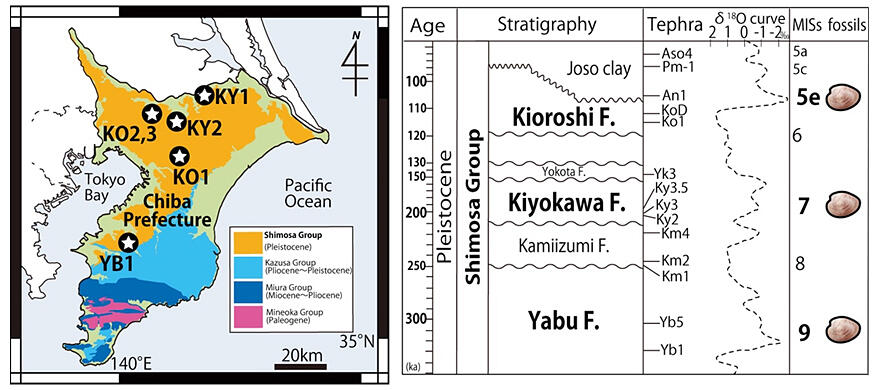A research group including Graduate Student Shiono Miki, Associate Professor Kotaro Shirai, Associate Professor Asuka Yamaguchi, and Emeritus Professor Kazushige Tanabe of the University of Tokyo, in collaboration with the Japan Agency for Marine-Earth Science and Technology (JAMSTEC), the National Institute of Advanced Industrial Science and Technology (NAIST), and the University of Mainz in Germany, has announced that they revealed the seasonal seawater temperature changes in the Paleo-Tokyo Bay. The research group used fossil shells of Mercenaria stimpsoni to find the aforementioned changes during past warm periods (approximately 100,000, 200,000, and 300,000 years ago).
Seasonal variations in seawater temperature were reconstructed using growth line analysis and oxygen isotope ratio analysis of the shells. The highest seawater temperature in Paleo-Tokyo Bay was found to be lower by more than 5℃ than the current seawater temperature in the coastal area of Chiba Prefecture. The findings are expected to be useful for predicting the future climate. The results were published in the November 1 issue of the international journal Palaeogeography, Palaeoclimatology, Palaeoecology.

Left figure: Shimosa Group distributes in the orange area in the Chiba Prefecture, central Japan. The star marks indicate the locations where the fossil specimens used in this study were produced.
Right figure: Shell marks indicate that fossil specimens are found in the Kioroshi Formation, the Kiyokawa Formation, and the Yabu Formation.
*The figures are modified from the original article.
Provided by the University of Tokyo
It is known that during past warm periods, which were approximately 100,000, 200,000, and 300,000 years ago, the whole globe was warmer, and sea levels were higher than today. During these periods, large areas that constitute the Kanto Plain today were covered by a sea called the Paleo-Tokyo Bay. While the Earth as a whole must have been warm, the seawater temperature in the Paleo-Tokyo Bay was unknown because fossil shells of Mercenaria stimpsoni, which lived in cold seas such as those around Hokkaido, were found for some reason in the Shimosa Group, which consists of strata of the same periods.
In this study, the research group aimed to reconstruct seawater temperatures by examining fossil shells of Mercenaria stimpsoni from the Shimosa Group in Chiba Prefecture. Well-preserved fossils of Mercenaria stimpsoni have been found in the Shimosa Group in Chiba Prefecture. Current Mercenaria stimpsoni is known to have a lifespan of approximately 100 or more years, during which the shells record the seawater temperatures as oxygen isotope ratios. Analysis of the growth lines of the fossil shells of Mercenaria stimpsoni showed that it also had a life span of at least 100 years.
Analysis of the types of minerals that make up the fossil shells and observation of their microstructure also confirmed that they are extremely well preserved and can be used to reconstruct the seawater temperatures at that time. Therefore, they took a series of samples in the direction of shell growth and analyzed the oxygen isotope ratios.
There are oxygen-16 and oxygen-18 isotopes, and the abundance ratio of these isotopes depends on the temperature and salinity of the seawater. The oxygen of calcium carbonate (CaCO3), a constituent of shells, is taken up from seawater. The temperature and salinity of the seawater when the shells were formed are recorded as oxygen isotopes. They measured oxygen isotope ratios with a mass spectrometer and reconstructed seasonal variations in seawater temperature using data from previous studies assuming a seawater salinity δ18O value of Paleo-Tokyo Bay at that time. When the number of analyses per year was increased, seasonal variations in seawater temperature became visible. It was possible to determine which parts of the shells were formed in the summer. The highest water temperatures were successfully revealed to have higher reliability than ever.
As a result, the highest seawater temperatures in the Paleo-Tokyo Bay were below 20℃ for all of 100,000, 200,000, and 300,000 years ago. This is more than 5℃ lower than the current seawater temperature in the coastal areas of Chiba Prefecture and is close to the seawater temperature in the coastal areas of Tohoku and Hokkaido. The cold seawater temperature of the Paleo-Tokyo Bay during the globally warm periods is considered to be attributable to cold-water masses, such as the Oyashio Current, that reached the Paleo-Tokyo Bay. If a detailed history of the marine environment at that time becomes available, it is expected to contribute to predicting possible future acceleration of global warming.
Shirai said, "Shellfish live in a wide range of environments, from the equator to the poles, from the coast to the deep sea, and in land, fresh water, and salt water. Fossil shells from ancient times as old as several hundred million years ago can also be obtained. As demonstrated in this study, analysis of shells can reveal paleoenvironments during the times the shellfish lived. Therefore, shells are important research materials that can provide the most detailed record of the Earth's history. There are still many things we don't know about the old Earth's environment, so we will continue to study fossil shells from various periods and places to elucidate the history of the Earth's environment."
Journal Information
Publication: Palaeogeography, Palaeoclimatology, Palaeoecology
Title: High temporal resolution paleoclimate reconstruction by the analysis of growth patterns and stable isotopes of fossil shells of the long-lived bivalve Mercenaria stimpsoni from MIS 5e, 7 and 9
DOI: 10.1016/j.palaeo.2024.112537
This article has been translated by JST with permission from The Science News Ltd. (https://sci-news.co.jp/). Unauthorized reproduction of the article and photographs is prohibited.




